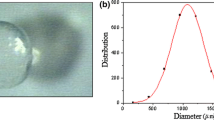Summary
The gelation or precipitation of alginate with a number of divalent metal ions occurs through cross-linkage, forming complexes which involve carboxyl groups of one macromolecule and pairs of hydroxyl groups of another. For most of the ions the pair of hydroxyl groups involved has to be vicinal and thus belong to one uronic acid residue. Only Cu2+ and Cd2+ seem to include single hydroxyl groups also. The extent to which these complexes are formed or, in other words, their stability depends greatly on the metal ion. Decreasing stability of complexes with different ions appears to be in the following order: Ba2+, Cd2+, Cu2+, Sr2+, Ni2+, Ca2+, Zn2+, Co2+, and Mn2+.
Another group of metals including tri- and tetravalent ions but also divalent ions with either very low or very high atomic weights form precipitates but apparently do not cross-link in any way.
Zusammenfassung
Die Gelierung oder AusfÄllung von Alginat durch eine Anzahl von zweiwertigen Metallionen geschieht durch Vernetzung, indem Komplexe gebildet werden, die Karboxylgruppeneiner Makromolekel und Hydroxylgruppenpaare einer anderen Makromolekel enthalten. Für die meisten Ionen mu\ das Hydroxylgruppenpaarvizinal sein, d. h. beide Hydroxylgruppen müssen dem gleichen UronsÄurerest angehören. Nur Cu2+ und Cd2+ können anscheinend auch einzelne Hydroxylgruppen mit einbegreifen. Der Bildungsgrad dieser Komplexe oder, mit anderen Worten, ihre StabilitÄt hÄngt sehr stark vom Metallion ab. Abnehmende StabilitÄt von Komplexen mit verschiedenen Ionen scheint in folgender Reihenfolge vorzuliegen: Ba2+, Cd2+, Cu2+, Sr2+, Ni2+, Ca2+, Zn2+, Co2+ und Mn2+.
Eine andere Gruppe von Metallen, die hauptsÄchlich drei- und vierwertige Ionen mit entweder sehr niedrigen oder sehr hohen Atomgewichten umfa\t, bildet zwar NiederschlÄge, vernetzt jedoch anscheinend in keiner Weise.
Similar content being viewed by others
References
Schweiger, R. G., J. Org. Chem.27, 1786 (1962).
Schweiger, R. G., J. Org. Chem.27, 1789 (1962).
Chaberek, S. andA. E. Martell, Organic Sequestering Agents (New York 1959) p. 25.
Thiele, H. andH. Affeld, Kolloid-Z.156, 14 (1958);Whistler, R. L., Industrial Gums, p. 64 (New York and London 1959).
Lefèvre, K. U. andB. Tollens, Chem. Ber.40, 4513 (1907); method modified byW. H. McNeely, Kelco Company (unpublished data).
Author information
Authors and Affiliations
Additional information
Presented before Division of Carbohydrate Chemistry 147th. Nat. Meeting of Amer. Chem. Soc., Philadelphia, Penna/U.S.A. April 1964.
Rights and permissions
About this article
Cite this article
Schweiger, R.G. Complexing of alginic acid with metal ions. Kolloid-Z.u.Z.Polymere 196, 47–53 (1964). https://doi.org/10.1007/BF01500025
Received:
Issue Date:
DOI: https://doi.org/10.1007/BF01500025



